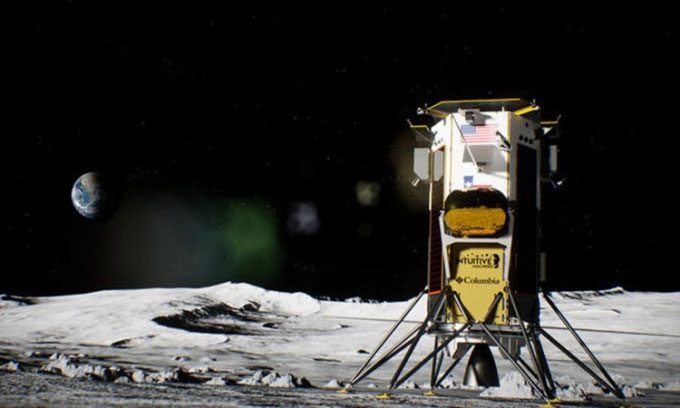The Odysseus spacecraft by Intuitive Machines has made history by becoming the first privately-funded spacecraft to land gently on the Moon in the early hours of February 23rd, according to Hanoi time.
After a tense descent and quiet period from the lunar surface, the Odysseus lander, built by Intuitive Machines in Houston, successfully landed near the lunar south pole on February 22nd. This is a monumental moment for space exploration. No private spacecraft has ever achieved a gentle landing on the Moon, and no American vehicle has touched down on this celestial body since the crewed Apollo 17 lander in December 1972.

Simulation of the Odysseus landing on the Moon. (Photo: CBS).
“This is a victory! The Odysseus has reached the Moon”, said NASA Administrator Bill Nelson after confirming the successful landing. “This achievement is a giant leap for all of humanity.”
NASA plans to establish a crewed base for the Artemis program in the Moon’s south pole region, which is believed to contain significant water ice resources. However, before sending astronauts there, NASA aims to gather more data about this less-explored area, such as the amount of water present and how easily this resource can be accessed. Therefore, NASA has initiated another program called CLPS (Commercial Lunar Payload Services), allowing American companies to develop automated lunar landers to carry scientific equipment.
In 2019, CLPS selected Intuitive Machines to transport NASA’s scientific instruments to the lunar surface using the company’s Nova-C lander, which is about the size of a phone booth. After some modifications, a mission worth $118 million was born. The lander transported six experiments and technology demonstration equipment from NASA in Intuitive Machines’ first lunar mission named IM-1. This mission utilized a Nova-C vehicle called Odysseus, named after the famous hero from Greek mythology.
The group of NASA’s $11 million development equipment is designed to conduct a series of explorations. For example, the Navigation Doppler Lidar (NDL) uses ground-penetrating radar (LIDAR) technology to gather data during the descent and landing phases. Another device is designed to study how spacecraft engine emissions interact with the lunar regolith. The spacecraft also carried automatic positioning technology testing equipment as part of a larger lunar GPS-like navigation system.
Intuitive Machines also transported six commercial payloads aboard the Odysseus during the IM-1 mission. One of these payloads came from Columbia Sportswear, which wanted to test its Omni-Heat Infinity thermal insulation material in deep space, along with a series of sculptures by artist Jeff Koons. The Odysseus also carried EagleCam, a camera system developed by students at Embry-Riddle Aeronautical University. EagleCam was deployed from Odysseus at an altitude of 30 meters above the lunar surface, capturing images of the lander’s descent from below.
On February 15th, SpaceX’s Falcon 9 rocket launched the Odysseus on its journey to the Moon. The deep-space flight of the lander was relatively short and smooth. The Odysseus reached lunar orbit on February 21st as planned. However, during the landing process, the ground control team discovered that Odysseus’s laser altimeter (which helps determine altitude and horizontal speed) was not functioning properly. As a result, the entire team utilized NASA’s NDL testing equipment to continue this critical function, delaying the landing by two hours.
The last-minute solution, where the team had to design software from the ground and send it to Odysseus, worked effectively. At 6:11 PM on February 22nd (US time), which is 5:11 AM on February 23rd (Hanoi time), Odysseus fired its main engine for 11 minutes to slow down its descent to the lunar surface. Then, at 6:23 PM US time the same day (5:23 AM on February 23rd Hanoi time), the Odysseus landed gently near the Malapert A crater, approximately 300 kilometers from the Moon’s south pole. The IM-1 team experienced 15 minutes of tension waiting for the signal from Odysseus.
If everything goes according to plan, the lander and scientific instruments will operate for about seven Earth days on the Moon. The IM-1 mission will conclude when the sun sets at Malapert A, as Odysseus is not designed to survive the freezing conditions of the extended lunar night.


















































